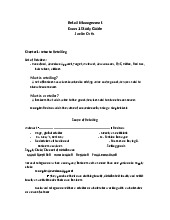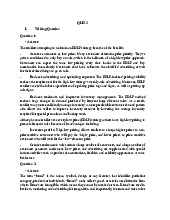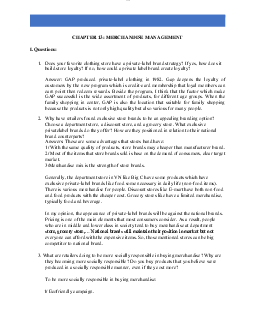


Preview text:
lOMoAR cPSD| 58097008 THEORY Chapter 6:
• Content 2 - Evaluating Specific Sites Chapter 7:
• Content 1 - What is a retail strategy?
• Content 3 - Strategic retail planning process
• Content 4 - Objectives and goals of a retail firm Chapter 8:
• Content 2 - Merchandise Planning Processes Chapter 9:
• Content 1 - Pricing strategies
• Content 4 - Pricing techniques for increasing sales and profit lOMoAR cPSD| 58097008 EXCERCISE
Type 1: ORDER QUANTITY/ ORDER SIZE
A retail store purchases a product from a vendor who offers quantity discounts to encourage larger
order quantities. The category manager of the store wants to determine the optimal order quantity to
minimize the total annual cost. The store’s annual demand forecast for the item is 5000 units, its order
cost is $49 per order, and its annual holding rate is 20%. The discount price is summarized below:
ORDER QUANTITY (UNITS) PRICE PER UNIT 1 – 999 $5.00 1000 – 2499 $4.85 2500+ $4.75
What is the optimal order quantity that the store should order to minimize its total annual cost?
https://ebooks.inflibnet.ac.in/mgmtp04/chapter/inventory-models-quantity-discounts/
Type 2: SETTING PRICES BASED ON COSTS
Q1. A clothing store buys a black leather belt for $85 and sets the retail price at $155. What is the markup
percentage for black leather belts?
Q2. In the sale season, a brown type of belt was bought for $125, a reduction is $50, and the actual sale price is $200.
• What is the maintained markup percentage that the company gets?
• What’s the initial markup percentage and initial retail price?
Q3. The cost of a genuine leather handbag is $450. What is each handbag’s final retail price to satisfy a
50% markup and a 20% markdown?
Q4. A department store’s net sales are $50,000, and reductions are $2600.
• If the maintained markup is given as 40%, what is the initial markup as a percentage? Explain
why the initial markup is greater than the maintained markup.
• If the initial markup is given as 40%, what is the gross margin in dollars? 2/3 lOMoAR cPSD| 58097008
Type 3: ABC ANALYSIS – ASSORTMENT PLAN
A convenience store is considering the investment into the list of SKUs as in Table 1.
1. Based on the annual sale, applying ABC analysis identifies the performance of each SKU in the
assortment plan. Determine what items should never be out of stock.
2. What is the GMROI & Inventory Turnover for each SKU?
3. Based on the results from (1) and (2), please determine the list of SKUs that need to be invested.
Table 1. Information of each SKU in the assortment plan SKUs Annual Average Inventory Gross
Sales-to-stock Inventory GMROI sale ($) at cost ($) Margin ratio Turnover (%) 1 420000 210000 24 2 170000 51000 28 3 190000 19000 14 4 150000 30000 30 5 120000 24000 44 6 190000 38000 43 7 190000 57000 37 8 120000 12000 25 9 150000 30000 50 10 160000 80000 17 11 150000 75000 33 12 170000 51000 16 13 180000 36000 44 14 120000 36000 27 15 170000 17000 11 \


